#terrestrial crocodiles were A LOT more common than most people know
Explore tagged Tumblr posts
Text
Probably not very accurate, but this is my favorite reconstruction of Terrestrisuchus, a land crocodile from the Triassic

I've been obssesed with this *design* ever since I was a kid. We COULD have little crocokitties but we were robbed.

#cosas mias#terrestrial crocodiles were A LOT more common than most people know#in fact the whole idea that crocodiles didn't really change is only true for semi-aquatic species#terrestrial crocodilians were incredibly weird and in lots of shapes#crocodiles#paleontology#triassic
50 notes
·
View notes
Note
I don’t rly know much about evolution or spec bio and such, so I was wondering, do you have any ideas of what kinda pets Squid Kids might have? And if you do + feel like sharing them, do you mind if other people work off those ideas? Thank you for your time!!
See I’ve only Vaguely thought about the Other Animals that live in the era, so this is a super hazy area for me! I only know super surface level stuff I think so this is a lot of work in Approximate Bullshit and coming across just enough specific questions to look up lol...
So this post will be an overview of Animals I Know About and whether making it a pet is a good idea or not! And people are welcome to work off of these ideas, absolutely! Thank u for asking, hopefully this is actually useful to u!
Ok, under the cut bc it was getting Slightly Long:
Quail Thing (possibly not actually a quail, but definitely a similar bird. I do not care enough to go into its actual evolutionary history so It Is A Mystery). Quails are one of the main domesticated animals on [Splat Japan], having been domesticated during the early stages of the Inklings’ civilization for their meat and eggs (later gaining more focus on feathers as well). There’s a lot of breeds with varying sizes and colors and shapes, similar to modern chickens and pigeons. They make excellent pets, and probably are one of the most common pets in the region.
Small Terrestrial Crocogator. Just what it says on the tin, a small, terrestrial crocodilian. I’m thinking like, japanese spitz height on average (10 to 16 inches at the shoulders. Sorry I was thinking of size refs and my own dog is the best thing I have lol). They are slightly omnivorous but definitely need a meat focused diet to thrive. I’m weak and I like crocors, so they have been domesticated mainly for use in hunting by... Not Inklings, I have not decided on who yet, but they’re from one of the continents. While they are domesticated they’re definitely more demanding in terms of food, proper training, and exercise needs, so they’re not a very common pet especially in Splat Japan. If you’ve got a lot of space, money, and time to dedicate to caring for god’s perfect animal, then a Littol Croc is not a bad pet at all.
Large Marine Crocodile, or Seal Croc. Also just what it says on the tin; a large nearly fully aquatic crocodile. They’re kinda mosasaur-ifying right now, with their legs becoming more like flippers. They spend most of their time in the ocean and only occasionally come up on land mostly for breeding purposes or just to sit in the sun for a little bit. These are decidedly not pet material. Untamable Apex predator. Also you’d need, like, a fuckoff huge tank for them.
Sea Hare (Probably will figure out a different name for them). They’re a closeish relative of the Sea Slug ppl. Not actually descended from actual sea hares at all, but looks like a lot like them but with short, stubby leggies. They’re fairly lazy, herbivorous slugs, usually the size of, say, a french lop rabbit. They were used as livestock by the Sea Slugs for mainly their meat. These are also a common pet these days among mollusk folks, since they do well in similar humidity/temperatures, and are also very conveniently lazy. Sea Hare breeds aren’t quite as varied as Quail Things, but there’s still a nice number of Options, and people are breeding more varieties these days. Overall, a very good pet, especially if u are a fellow Damp Animal.
Hedge Urchin (names are the worst part of animals!). This is basically a sea urchin that has become a hedgehog. Except they are herbivorous! There’s different species of these things with slightly different diets and therefore mouths, but the one I have drawn likes to scrape moss and lichen and such off of rocks. Probably. They have very primitive eyes that really only detect the direction of where light is coming from. Their spines are venomous, like all urchins; while you wouldn’t need serious medical attention unless you were allergic, it’s very painful and usually causes a lot of swelling around the wound. People have recently started keeping these as a Cool Exotic Pet, but it’s not advisable to handle them due to their spines. Definitely a hands-off pet, if you’re gonna keep one.
Various Lizards and Snakes. Nothing that different from things u might see today, though probably different species. There’s a lot less stigma around them than there is today, though, so they’re more common.
Various Buges and other Arthropods. You know... beetles, spiders, terrestrial isopods, etc... People keep some. “Bugs” are considered a little more unusual/creepy than reptiles, except for by arthropod folks. Crabs are also Not Creepy as pets.
Fish. We keep fishies. They also keep fishies. There are also a handful of smaller amphibious fish nowadays that ppl try to keep, but not all species are suitable for private keepers just because they can be pretty Sensitive. To Note: actual “amphibians” like frogs and salamanders are like 90% extinct, and remaining species tend to be Highly Protected and illegal to keep.
Horse Bird, basically a Cool Ostrich Thing that is larger and better suited for riding than modern ostriches. These are definitely Large Livestock. I guess they are the same degree of Pet Material as a horse.
Small Whales. Not very many of them, and nothing much bigger than a beluga. They are whales. As you can imagine, they do not make good pets, as they are whales.
Side Note: Dolphins. These are not really animals. They are pretty much recognized to be sapient, however, many of them enjoy the challenge of hunting other sapients for food and kinda voluntarily uninvited from the Cool Sapient People Table. Salmonids and Dolphins clash the most because they both live in the sea. International legal protocol is to drive them away from inhabited coastlines and ships and otherwise leave them the fuck alone. They are not pets.
There are Other Animals, most of them unsuitable for pets, some of them probably alright pet material, but they are unknown to me at the moment (or I’m forgetting). A huge chunk of animals are birds and reptiles though, with Formerly Aquatic Animals being more of a minority. Also, Bugs are still king. It’s hard to come out of the water dude. Thanks for readin’
#different sapients have different inclinations towards bonding with aninmals though#Inklings bond with things very easily as do the land fish and they love keeping pets#Salmonids and Octos and Sharks have the least Animals Cute response on average#and thus not many of them keep companion animals#Squid 2 the evolution of the squid#Splat Bio#i love calling sharks and crocs and such ''gods perfect animals'' as a joke#urchins are also gods perfect animals. as are jellies#Anonymous#asks
36 notes
·
View notes
Note
Dear Koryos: Can you imagine a universe wherein bats have become the ancestors of some kind of Highly Intelligent Life Form (not necessarily humanlike intelligence, but something as different from today-bats as humans are different from Ancient Primate Ancestor)? I originally just was thinking about what kind of Cultural Norms such beings would have, but then I realized I couldn't really imagine anything except bat-shaped things that more or less thought like humans.
I’ve sat on this question a while because it’s such an interesting one to me. The biggest issue here is that you’d have to specify which bats you’re making your theoretical ancient ancestor, because there’s such a vast diversity of behavior within the group. A vampire bat would be different from a sac-winged bat would be different from a hoary bat would be different from a flying fox ancestor, is what I’m saying. Any social or behavioral organization paradigm that you can think of, there’s a bat that has it.
So to think about what a sapient bat would look like, we first need to assess the intelligence and behavior of possible ancestral bats. And here I’m gonna stick a readmore, because this gets looooong.
Assessing which species would make a good sapience ancestor based on intelligence is also tricky, in large part because bat intelligence remains mostly under-examined. Bats as a whole share the rough reproductive hallmarks of other intelligent mammals and birds, in that they have long lifespans and small litter sizes (in most cases, a single pup). They also have unusually high whole brain size and EQs for their body size, though this is often attributed to the fact that they need more brain matter to handle echolocation.
However, if you look at EQs across Chiroptera, the general trend is that vampire bats and flying foxes tend to have the largest, followed by bulldog bats, false vampire bats, the fruit and nectar eating bats of Phyllostomidae, followed by most other Yinpterochiropteran groups, and then finally the remainder of the insectivorous bats. The authors of the particular paper I’m referencing suggest that this has to do with lifestyle- bats that specialize on blood, fruit, or non-insect prey may require more intelligence to solve the unique problems posed by their food sources compared to insect-eating bats. But the authors do admit that insect-eating bats may also have been constrained by the need to keep their brains smaller and lighter to allow for faster flight, and it’s entirely possible they’re doing more with less. (Also, it’s important to remember that EQ is an imperfect method for assessing intelligence anyway.)
More than one insectivorous bat species is known to have vocal learning and the capacity to imitate, and it’s highly likely that many others do, given the complexity of bat vocal repertoires. Fruit bats, particularly the Egyptian fruit bat, also display vocal imitation. This is considered pretty smart stuff, and among animals only humans, birds, cetaceans (dolphins and whales), pinnipeds (seals), and elephants are known to be regular vocal imitators, putting the bats in a pretty high-class group. Some researchers are now arguing that bats are better candidates for studying the development of human language than birds are, given their closer relationship to us and various other similarities between our vocalizations. There’s even some emerging evidence that some species of bats may recognize each other by vocal signals unique to each individual (in other words, names). In spite of all this, bat vocalizations remain largely understudied, but it’s clear all their chatter serves a purpose.
I bring up all these points because I like reminding people how smart and cool bats are because it emphasizes that intelligence matters in different ways to each bat group, but all of them show the potential for vocal complexity that could approach that of a human’s. So wherever our theoretical sapient bat comes from, it’s likely to be noisy. (Though maybe at frequencies we can’t hear.) Now, if we look at other measures of intelligence such as tool use and environment manipulation, the evidence is more on the side of fruit-eating bats, specifically flying foxes. Though I’ve never seen one use a tool per se, they are perfectly capable solving complex problems using object manipulation. For example, pulling a plastic chain up link by link to get fruit attached to the end involves a similar amount of intelligence as the animals in that famous raven-gets-meat-on-a-string study. They’re also capable of figuring out grenade feeders (feeders in which “pins” have to be removed to make the food drop out) and sometimes will carry around small objects for no apparent reason.
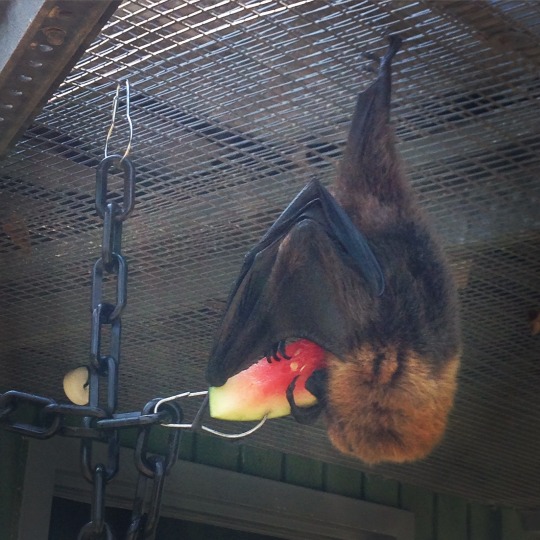
The unusually long thumbs of flying foxes allow them to manipulate objects with surprising precision and they may also use their feet and even wingtips to this end. Object manipulation is part of their natural repertoire (for example, pulling a branch closer to get at something tasty). This separates them somewhat from non-frugivorous bats, who don’t usually need to manipulate objects in pursuit of food- blood-drinking bats just gotta find a spot to bite, carnivorous and piscivorous bats swoop down like hawks, and the most manipulation I’ve seen an insect-eater do is use their tail membrane as a scoop to toss a bug into their mouth. If you want a sapient bat with lots of tool use, fruit-eaters are your likely ancestral group.
However, bats can alter their environment and get better access to food in quite intelligent ways without using objects. Here we ought to look at vampire bats. The white-winged vamipre bat, which feeds primarily on the blood of birds, has co-opted the behavior of domestic chickens in at least two ways. Some bats may perch on the exact spot on a hen’s back that causes her to assume the lordosis posture (i.e., the bout-to-get-boned posture) and feed from the back of her comb with her holding completely still. Others will press up against her brood patch, imitating a particularly goblin-faced little chick, causing her to nestle down on it as the vampire has its meal. This is incredible stuff, as these tactics couldn’t be utilized against their traditional avian prey- meaning the bats have learned how to manipulate chickens all on their own!

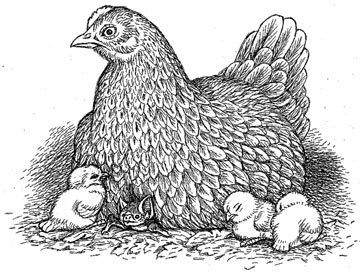
Common vampire bats prefer hoofed mammals to birds, and given the larger size of their prey usually don’t have to resort to such nefarious tactics to stay unnoticed. But their creativity also shines when their normal (at this point, human-introduced) prey isn’t available, and they proceed to feed on whatever they can find- which might include sea lions, rats, crocodiles, porcupines, turtles, and even venomous snakes. Each of these critters requires a different strategy on the bat’s part, but apparently the bats tackle the situation with ease. Indeed, one account tells of a vampire bat taunting a rat snake, easily avoiding each strike, until the snake was too exhausted to do anything as the bat brazenly sipped blood from its nose. It should be noted that this particular snake species specializes on feeding on bats.

So in comparison to a sapient fruit bat, a sapient vampire bat might be much more focused on manipulating the behavior of other species, perhaps even domesticating animals for its own use. I should mention, however, that one species of vampire bat- the hairy-legged vampire bat- has evolved a kind of opposable thumb on its foot (a sixth digit fashioned from the calcar), not found in any other bat species. It uses this thumb to help it grip branches as it scuttles around nibbling bird toes, but if you were to make it sapient, you might imagine that instead of the thumb-based object manipulation seen in pteropodids, this fellow would manipulate stuff with its feet. (No relation to the horrible Dougal Dixon futurebats, though, please.)
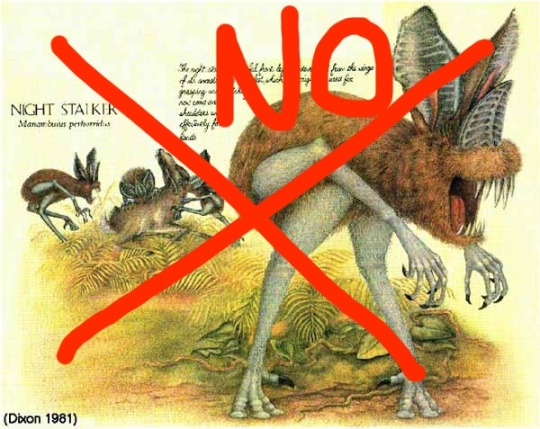
Speaking of horrible future bats, most of the speculative future bats I’ve seen have two things in common- a) flightlessness and b) a loss of vision in order to rely primarily on echolocation. But neither of these things are really plausible. I’ve discussed why it’s highly unlikely for bats to evolve flightlessness before, so I won’t go into too much detail here, but suffice it to say that unlike birds, which sometimes seem to drop flight as soon as they can get away with it, no bat has evolved to be flightless even when in the most prime conditions. The degree of specialization they have for flight would make it pretty hard to go back to a terrestrial lifestyle, in fact- at best I can imagine a short-flighted bat that flaps from tree to tree.
Some might argue that evolving the brainpower for sapience would necessitate flightlessness because of how heavy and energy-draining such a big brain would be, but just because that’s how humans do it doesn’t mean it HAS to be done that way: look at the brain sizes of highly intelligent birds, such as corvids and parrots- still flying, and quite well. (And the birds that HAVE evolved secondary flightlessness aren’t exactly known for their brainpower). I couldn’t find any information on the neuronal density of bat brains, but I’d bet that it’s higher than expected, given the dizzying amount of calculations that have to take place in an echolocating, flying, insectivorous bat’s head to be successful.
Sightlessness is as unlikely in bats as flightlessness... again, no bat species we know of, living or extinct, has lost its vision! In fact most bats have pretty good vision, despite the reduced size of the eyes of some species. No bat species lives in complete darkness all the time, which would be what would render vision obsolete- vision is still better off than echolocation when it comes to spotting daytime/dawn/dusk/moonlight predators on the move.
Granted, some species have almost lost the ability to see forward due to specialization for echolocation, I’ll give you that...
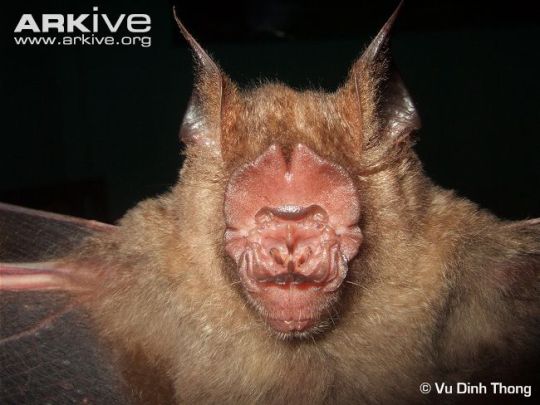
But they still have quite nice eyes. (And note how slits in the noseleaf allow for a little forward vision.)

In any case if our hypothetical bat evolved from a pteropodid/flying fox it wouldn’t have any echolocation at all, because they don’t echolocate, with the exception of Rousettus species, who do it via tongue-clicking. (And there’s some evidence that other pteropodids have like, a ~mystery~ version of echolocation using their wings, but we hardly know anything about that right now.) Pteropodids are also largely crepuscular- active at dawn/dusk- rather than fully nocturnal, as well, and their primary sense is vision, which accounts for their sometimes inappropriately large eyes.
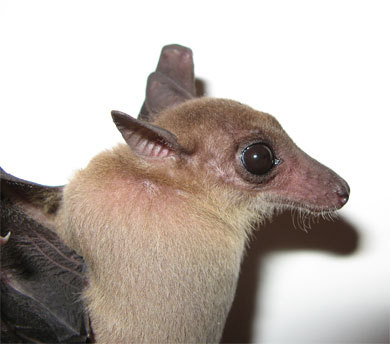
Speaking large-eyed, fruit eating critters, I can say with confidence that the behavior of large pteropodids I worked with reminded me very much of the macaques I’d once worked with. Even though it’s been debunked that bats and primates are close relatives, I think large flying fox behavior is very similar to cercopitheceine primate behavior (as well as spotted hyena behavior in some ways). Their social organization is a mixed-sex, hierarchical, fission-fusion sort of society, where mating is promiscuous, coalitions can form around power grabs, and competition for spotty resources is quite fierce. Infantacide does occur in fruit bats as in primates, though I’m not sure if there’s been any study on how common it is.
Compare this to the social structure of the common vampire bat, though. Female vampire bats will shift roosts freely and form multiple-matriline groups, usually with a single or two or three males in attendance. These males defend their “harems” from other males, but there’s not much evidence for female policing as in primates, given that females regularly swap roosts; rather, the males seem focused on defending the favorable roosts themselves.
In addition, female vampire bats are pretty famous models of reciprocal altruism, that is, I’ll-scratch-your-back-if-you-scratch-mine behavior. Because they feed entirely on blood, the bats can’t build up any fat reserves, and over 24 hours without feeding can starve them. To combat this, they have a complex network of blood donors (via regurgitation, not vein-piercing) that they turn to in times of need; it’s based on kinship but even more so on how familiar they are with the bat in question, and whether or not they give blood as well when it’s their turn.
Spectral bats are strict carnivores that eat rodents, lizards, birds, and other bats. They’re notable for being a monogamous species, with two parents raising one pup together while defending a hunting territory, and in some cases the offspring of previous years may stick around to help as well, in the manner of canids and some bird species. An even more exceptional monogamous bat is the Dayak fruit bat, where males lactate as well as females. Check out the armpit-nipples of the lactating male, below.
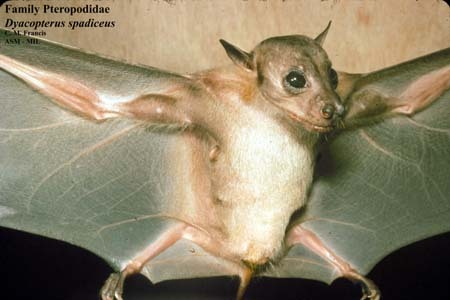
Many other bats have lek breeding systems, like the hammerhead bat, where males congregate together to perform for females, but otherwise the sexes live separately; other species have males that fly completely solo and sing like birds to attract a mate; in other species like the hoary bat both sexes normally live solitary lives.
Most cave-dwelling insectivorous bats stay in sex-segregated groups until it comes time for hibernation, in which case they cluster together in caves, mate, and nap. Social behavior among these species is probably the most poorly understood, given that they are often tucked into near-unreachable places during the day.
Of course, the social behavior in the vast majority of all bat species hasn’t been studied at all, so who knows what other forms their societies might take? I particularly await with eagerness the discovery of a polyandrous bat species similar to tamarins and marmosets... It’s not unfeasible, given the large size of newborn bats (a pup may be up to 1/3 the weight of its mother) and the fact that they often need to be carried rather than hidden, meaning poor mom has gotta carry them while flying, and in some species it can take two years or more before they’re able to survive on their own- as in our small primate cousins, having two dads could really make life easier. I mean... look how big this newborn ghost bat pup is. (And if you’re brave, watch this evening bat giving birth... that looks painful.)

Anyway.
An important indicator of high intelligence would be a great degree of behavioral flexibility (which can lead to transmitted culture) within a species. I don’t think the social behavior of any bat has been studied thoroughly enough to assess how flexible their lifestyles are between groups, but I would bet vampire bats are among some of the most adaptive, as well as some of the most socially receptive and cooperative.
On the other hand I would love to do a study on observational learning in pteropodid bats; I bet they’d do really well. It’s already been shown that they can learn to understand and respond to human pointing gestures.
I guess my ultimate point is, you could expect a sapient bat to behave very differently based on its ancestral lifestyle and morphology (especially whether or not it echolocates) but sapience would imply a degree of behavioral diversity that wouldn’t be limited to any one set of cultural norms. Which is why I hesitate to say any sapient bat would behave just like such-and-such species, but smarter.
It would be very interesting, though, to design a theoretical culture based on creatures that are flighted (travel would be much easier, but energy requirements much higher, how are the flightless elderly cared for?), or one that drinks blood (would certain species’ blood become taboo? what sorts of species might they domesticate and how would they keep them?), one that primarily hangs upside-down in branches (artificial perches would have to go everywhere), or most especially, one that echolocates. I can only imagine the diverse sorts of oral traditions that an echolocating sapient species would have.
Hope this long, long answer gave you at least some degree of what you were looking for! And thanks for the question.
496 notes
·
View notes